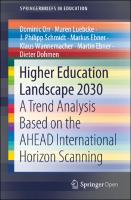Higher Education Landscape 2030
A Trend Analysis Based on the AHEAD International Horizon Scanning
| dc.contributor.author | Orr, Dominic | |
| dc.contributor.author | Luebcke, Maren | |
| dc.contributor.author | Schmidt, J. Philipp | |
| dc.contributor.author | Ebner, Markus | |
| dc.contributor.author | Wannemacher, Klaus | |
| dc.contributor.author | Ebner, Martin | |
| dc.contributor.author | Dohmen, Dieter | |
| dc.date.accessioned | 2020-06-15T15:08:09Z | |
| dc.date.available | 2020-06-15T15:08:09Z | |
| dc.date.issued | 2020 | |
| dc.identifier | ONIX_20200615_9783030448974_23 | |
| dc.identifier | OCN: 1156632890 | |
| dc.identifier.uri | http://library.oapen.org/handle/20.500.12657/39550 | |
| dc.description.abstract | This open access Springer Brief provides a systematic analysis of current trends and requirements in the areas of knowledge and competence in the context of the project “(A) Higher Education Digital (AHEAD)—International Horizon Scanning / Trend Analysis on Digital Higher Education.” It examines the latest developments in learning theory, didactics, and digital-education technology in connection with an increasingly digitized higher education landscape. In turn, this analysis forms the basis for envisioning higher education in 2030. Here, four learning pathways are developed to provide a glimpse of higher education in 2030: Tamagotchi, a closed ecosystem that is built around individual students who enter the university soon after secondary education; Jenga, in which universities offer a solid foundation of knowledge to build on in later phases; Lego, where the course of study is not a monolithic unit, but consists of individually combined modules of different sizes; and Transformer, where students have already acquired their own professional identities and life experiences, which they integrate into their studies. In addition, innovative practice cases are presented to illustrate each learning path. | |
| dc.language | English | |
| dc.relation.ispartofseries | SpringerBriefs in Education | |
| dc.subject.classification | thema EDItEUR::J Society and Social Sciences::JN Education::JNM Higher education, tertiary education | en_US |
| dc.subject.classification | thema EDItEUR::K Economics, Finance, Business and Management::KJ Business and Management::KJU Organizational theory and behaviour | en_US |
| dc.subject.classification | thema EDItEUR::J Society and Social Sciences::JN Education | en_US |
| dc.subject.other | Higher Education | |
| dc.subject.other | Organization | |
| dc.subject.other | International and Comparative Education | |
| dc.subject.other | Business and Management | |
| dc.subject.other | Higher education systems | |
| dc.subject.other | Learning pathways | |
| dc.subject.other | Education organizations | |
| dc.subject.other | Practical case studies in education | |
| dc.subject.other | New didactics and learning theories | |
| dc.subject.other | Knowledge in a Digitalized World | |
| dc.subject.other | Digital learning | |
| dc.subject.other | Open Access | |
| dc.subject.other | Higher & further education, tertiary education | |
| dc.subject.other | Organizational theory & behaviour | |
| dc.subject.other | Education | |
| dc.title | Higher Education Landscape 2030 | |
| dc.title.alternative | A Trend Analysis Based on the AHEAD International Horizon Scanning | |
| dc.type | book | |
| oapen.identifier.doi | 10.1007/978-3-030-44897-4 | |
| oapen.relation.isPublishedBy | 6c6992af-b843-4f46-859c-f6e9998e40d5 | |
| oapen.imprint | Springer | |
| oapen.pages | 59 |

